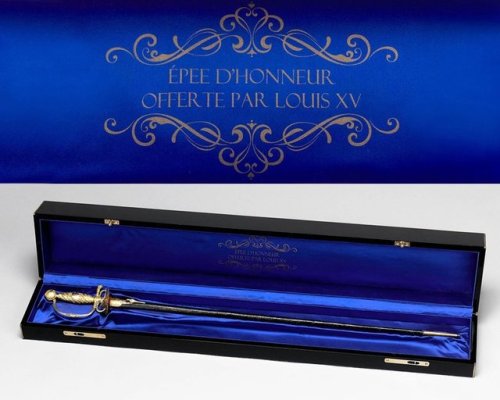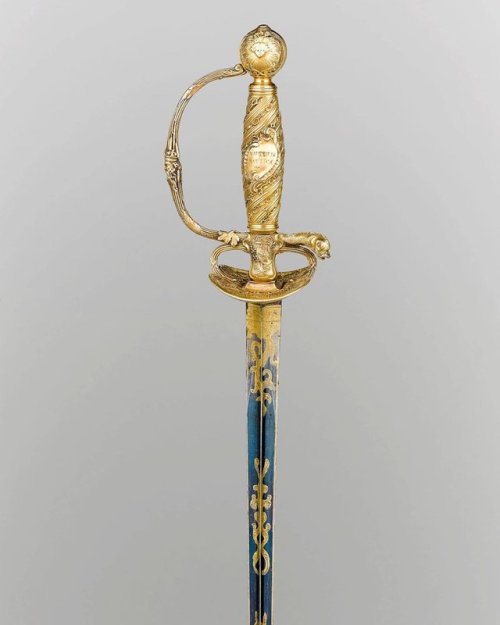Louis XV Royal Presentation Sword, circa 1730.This remarkably rare silver gilt presentation sword wa
Louis XV Royal Presentation Sword, circa 1730.This remarkably rare silver gilt presentation sword was a personal gift from Louis XV, King of France, to the Captain of the Corsairs, Alain Porée. Adorned by a myriad of gilt marine motifs, it is one of two Royal swords presented by the French monarchy to the celebrated corsair; the first was gifted to Porée by Louis XV’s great grandfather, Louis XIV. Apart from these two blades, only two other corsair presentation swords are known to have ever been gifted by the French monarchy – one is currently held in the Musée National de la Marine in Paris, while the other has not been seen since it was presented, and is presumed lost. Wielded by one of France’s favorite corsair-privateers and gifted by one of its most beloved monarchs, the blade stands as an important and rare relic of a momentous era.The work of two of the most famed orfèvres du roi, or royal silversmiths, to the King of France, this extraordinary presentation sword was designed by the great Juste-Aurèle Meissonnier and crafted by Thomas Germain, a craftsman widely considered to be the most important silversmith in history. Provenance aside, every inch of this sword features workmanship of unbelievable quality, with even the smallest detail executed with breathtaking precision. Germain is known to have made a number of silver pieces for the French monarch and other royal patrons throughout Europe, including the Queen of Spain and the King of Portugal, though few survived the French Revolution. So highly coveted are his works, a Royal soup tureen crafted by Germain for King Louis XV brought the highest price at auction for a single piece of silver - $10,287,500.An undeniable treasure of French silver craftsmanship, the sword also holds remarkable significance in France’s military history. Alain Porée was a fascinating figure in the French naval legacy. A famous corsair, or privateer, Porée was born in Saint-Malo, a city known as the cité corsair. The port city of Brittany became notorious as the “home of the corsairs” in the 17th century; Porée’s own grandfather, Jean Porée, was also a corsair of great reputation, and the Porée family was one of the oldest notable families of Saint-Malo.Though they were not considered official naval personnel, corsairs were authorized to raid the ships of any nation at war with France, all in the name of the French monarchs. Seized cargo, which was then sold at auction, was a lucrative business for the corsairs and the French monarchs, and the most successful corsairs were highly prized by their Kings. Only 15 years old at the time of his first voyage, Porée became a corsair of repute by the age of 24. For his role defending Saint-Malo against the English in 1693, he would earn his first Royal gifts from King Louis XIV – a presentation sword, along with a diamond encrusted portrait of the monarch.His triumphs at sea would eventually earn him a place among the nobility, and in 1711 he was made the Conseiller-Secretaire to the king, though he remained first and foremost a corsair. He was still sailing in 1728 when, at the age of 63, his valor at sea against pirates from Tripolitania earned the attention of King Louis XV, who presented him with this sword as a rare insigne d’honneur (mark of honor). A copy of a letter preserved in the Porée family archives shows that the Comte de Maurepas, Minister of the King’s Household, Minister of the Navy and Minister of the French Colonies, wrote the following on October 19, 1729:To the Sieur Porée at Saint-MaloIn the report that I gave to the King concerning the different attacks that had been launched against the Lybian forces, I did not forget to stress the importance of the zeal with which you sailed against the Barbary fleet. His Majesty, thus informed of the courage and valor that you have again shown on this occasion, has awarded you a sword which is the most honorable mark that the Crown bestows upon those who distinguish themselves by their acts of heroism; you shall receive it shortly.As Kings typically bestowed titles, medals or promotions upon their favored subjects, a presentation sword was considered one of the greatest honors one could receive. The fact that this rare gift was conferred upon a corsair makes it even more remarkable.The blade itself is slender and decorated on each side with numerous royal and marine embellishments, including two portraits of war vessels on the shell-guard that no doubt symbolize the two great ships under Porée’s command: The Saint-Espirit and the Notre Dame de l’Assomption. On the sword’s knuckle guard is the crowned head of Neptune, the Roman god of the sea; his image signifies both the royal and naval origins of the gift. The Royal Coat of Arms adorn the outward side of the shell-guard, each of which are flanked by the Wings of Victory, while a portrait of King Louis XIV graces the escutcheon. An inscription on the blade reads Virtutis Nauticae Praemi Um, which can be translated as “Naval bravery deserves a reward.” Under each valorous inscription is engraved a fleur-de-lis surmounted by a “V” symbolizing Porée’s lifetime of victories in the name of France and her king.An extraordinarily elaborate luxury, the quality of Porée’s sword can be compared to the rarely found swords of the Cent Suisses and the Gardes de la Porte (King’s guard) from the same period. Only a few examples of these are still known, and most are held in important public museums or royal collections in Europe. To find a comparable corsair presentation sword, which is much rarer, is truly remarkable.Meissonnier’s designs for this sword are held in the collection of the Metropolitan Museum of Art, and copies of them accompany this sword. Also included with this masterpiece are documents from the Musée de Saint-Malo and the ancestors of Alain Porée, -- source link
#history#antiques#french history#ornate#swords



